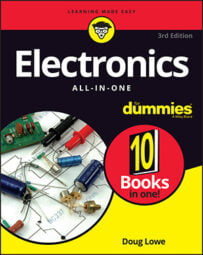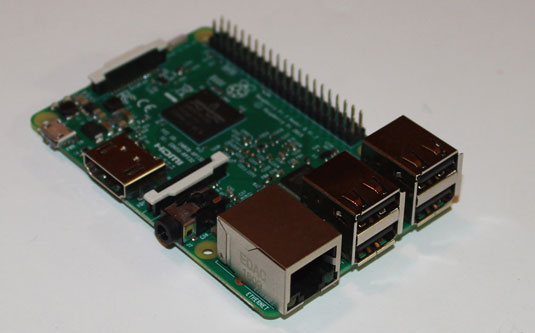Physically, a Raspberry Pi resembles an Arduino or a BASIC Stamp. However, the Raspberry Pi is much more than a microcontroller; it is a full-blown computer system, implemented on a single small card. In fact, a Raspberry Pi has most of the features commonly found on a desktop or laptop computer.
Yet, besides its small size, a Raspberry Pi has other features not commonly found on a desktop, such as the ability to directly control digital I/O pins. Thus, you can use a Raspberry Pi with external devices such as LEDs, push buttons, potentiometers, various types of sensors, and servo or stepper motors.
It contains most of the components found in a traditional desktop computer, but all squeezed onto a small board about the size of a deck of playing cards. The newest version of the Raspberry Pi, called the Raspberry Pi 3, is pictured here.
This version of the Raspberry Pi includes all of the following packed onto the board:
- CPU: A quad-core 64-bit ARM Corex-A53 microprocessor running at 1.2GHz.
- RAM: 1GB.
- USB ports: Four standard-size USB 2.0 ports mounted on the board. These ports can be used to connect any USB device, including a keyboard, a mouse, or a flash drive.
- Video: A built-in graphics processor that can support 1080p resolution (1920 x 1080).
- HDMI: A full-size HDMI connector is mounted on the board to connect a video monitor.
- Display serial interface (DSI): A display interface designed to connect to small LCDs via a 15-pin ribbon cable.
- MicroSDHC card: The MicroSDHC card acts as the computer's disk drive. The operating system (Linux) is installed on the MicroSD card, along with any other software you want to use.
- Ethernet networking: A built-in RJ-45 connector for networking.
- 802.11n wireless network: A built-in wireless network connection. The antenna is actually built into the board itself, so no external antenna is needed.
- Bluetooth: Built-in Bluetooth networking for wireless devices such as a keyboard, a mouse, and headphones.
- Camera serial interface (CSI): A special interface designed to connect to a camera device via a 15-pin ribbon cable.
- Audio: A 3.5mm audio jack for sound applications.
- Power: The Raspberry Pi is powered by a 5 V supply connected to the board via a micro-USB connection, the same type used by most smartphone rechargers.
- GPIO header: The most interesting thing about the Raspberry Pi from an electronic enthusiast's perspective is the 40-pin GPIO header, which provides access to a variety of features, including 26 general-purpose input-output (GPIO) pins. These pins work the same as the digital I/O pins found on Arduino and BASIC Stamp microprocessors, and can be accessed via programs that you write for the Raspberry Pi. You can use these GPIO pins as output pins to connect to devices such as LEDs, servo or stepper motors, and so on. Or, you can use them as input pins to read input from external switches, potentiometers, or other types of sensors.
Unlike the digital I/O pins found on Arduino or BASIC Stamp microprocessors, the Raspberry Pi GPIO pins work at a voltage level of 3.3 V rather than 5 V to indicate HIGH signals. You'll need to adjust your circuits accordingly to deal with the smaller input and output voltage levels. In particular, if you apply a 5 V input to GPIO input pin, you run the risk of damaging your Raspberry Pi.


